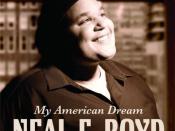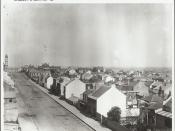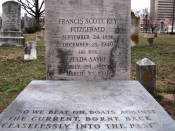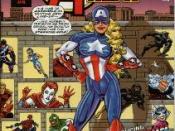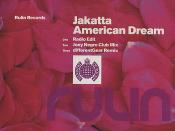The American dream has always been based on belief that everybody from anywhere can make it in society by working hard. This person will in turn become wealthy and rise in the hierarchy of the community to help create the American society, a classless society full of wealthy individuals. The American dream is also based on whether that person appears happy and is able to enjoy the newfound wealth. In The Great Gatsby, F. Scott Fitzgerald dispels the myth of an American classless society. This is shown with the differences of the three geographic regions and the people who reside in them seem segregated to their specific region depending on social status. West egg is symbolic of the new money or the money that is made by a person who does not descend from a family of wealth. The valley of ashes is the sullen, gray, and depressing region where the American dream of the classless society is completely non-existent.
Finally, East Egg is symbolic of the old money and family name that has been passed down throughout the generations. In light of these examples of different social regions the American dream of a classless society is non-existent in The Great Gatsby.
West Egg is one of the geographic regions where the classless society is dispelled. People who live in this region are wealthy from personal gains. These people who live in west egg are not seen as equals in comparison to the people living in east egg. The reason for this is that individuals who live in West Egg do not have the rich lineage. The main member of West Egg that represents this perfectly is Jay Gatsby. Jay Gatsby was a poor working class individual who changed his name from James Gatz in pursuit of the American dream. His wealth was attained illegally through pharmacies that sold bootleg liquor. Therefore he did not rise out from the gutter with hard work and perseverance so he did not truly achieve the American dream. The people like Gatsby who live in this region try to hard to fit into this classless society. This is apparent with Gatsby's car, which symbolizes money and his lack of breeding. Breeding is seen as having the rich ancestors or relatives that pass the money and the name throughout the generations. Another example is Gatsby's library of uncut books. Gatsby had gone so far as to create the persona of him being an intelligent man having real written books instead of books with blank paper. The aspect of this that shows appearance vs. reality is that Gatsby has not read any of the pages of these books that remain sealed and uncut. This shows once again Gatsby's lack of breeding. Gatsby Attempts to seem sophisticated and as one of the elite are primarily targeted toward Daisy Buchanan. Daisy represents what Jay Gatsby wants in his life as part of his American Dream. Gatsby feels that if he can spend money outlandishly he can impress Daisy, which would then in turn aid Gatsby's assimilation into society. Because of this fact alone it shows that Gatsby is unhappy and insecure with himself and that he hides behind his money. Thus, the unhappiness, the instance of one class trying to fit in with another dispels the American dream of a classless society.
The Valley of Ashes is another prime example of how the American dream of a classless society is dispelled. This is because it is the "human dump" of all the geographic regions and is symbolic of hopelessness. The Valley's location is similar to a no-mans land in itself. It is the barren area between two classes in a struggle involving money. The name of the valley symbolizes how the ashes represent how people come with hope fail and are added to the ash heaps of modern society. An example of this is Dr. T.J. Eckleberg's billboard. This billboard depicts the picture of the glasses and eyes of Dr. T.J. Eckleberg. Dr. T.J. Eckleberg has long since moved away because of troubles with the business in the Valley of Ashes. This shows that no matter how hard someone works or no matter how much effort is put into something that in the Valley of the Ashes Unevitably anyone will fail. In the American dream of a classless society if someone works hard he or she profits from it, and the people in the people in the Valley of Ashes work hard, do not profit and do not assimilate into the classless society. This point is show with the poverty of the people currently living in the Valley of Ashes. Even though anybody who lives there has/had dreams at one time it is inconceivable that anybody will attain them. For example, George Wilson owns the gas station in the Valley of Ashes. He has lived in the Valley of Ashes and invested a lot of time, effort and money into his business with little hope for profit. This has in fact made him worn down, depressed and very much the stereotypical example of a man in the Valley of the Ashes. George's wife named Myrtle attempts to live like an elite member of society by being mistress to the rich dashing Tom Buchanan. When Myrtle is with Tom she feels as if she is rich, sophisticated, and that she is socially equal, or greater with everybody. This is important because it shows her unhappiness with her situation in the Valley of the Ashes, and is used to mask the unhappiness. In reality she is the lower class wife who happens to be married to an unsuccessful businessman with no sense of breeding. This is important because Myrtle married George because she thought he had a sense of breeding. Because of this Myrtle is even unhappier because her husband is a total contrast concerning the person she thought she was marrying. Unhappiness is seen as an inhibitor of the American dream and it is obvious that anybody who lives in the valley of the Ashes are not social equals to the rest of society, and thus proves a point that there is no American classless society in The Great Gatsby.
Finally East Egg dispels the myth of the American dream of a classless society. This region differs from west Egg and The Valley Of Ashes because this is where the people of old money live. Old money of the wealth passed down throughout ones family throughout the generations. A strong example of the typical family that lives in East Egg is Tom and Daisy Buchanan. There is much pride and wealth that come along with the Buchanan name and it is shown with Tom's demeanor as an arrogant man. This could be shown with a quote from Tom toward George Wilson "Do you want me to get out and serve myself? You sounded well enough on the phone" (Fitzgerald 128). This shows that Tom I talking down to George who happens to be apparent of the lower class. Tom talks this way to George because he knows he is socially superior. If George were a fellow "East Egger" Tom would not have spoken down to him. Another point that differentiates Tom from a person from West Egg, Mainly Gatsby, is that he does not go half as far as Gatsby does concerning the unnecessary frills in life. Tom does not have to prove his wealth because he lives in East Egg and the social status of "East Eggers" and their lasting legacies of the family names are well known. The people who reside in East Egg fee they are higher on the "food chain" when they are compared to those citizens in the Valley of Ashes or West Egg. All of this is important because it shows the invalidity of the American classless society because how can a society be classless if there is a dominating upper class that alienates and intimidates another class. This is important because if the society were classless it would not involve a conflict such as social discrimination and segregation.
Therefore the American dream of a classless society in non-apparent in The Great Gatsby. F. Scott Fitzgerald in The Great Gatsby dispels it with the distinct and different social classes. West Egg is the new elite that has to prove itself to the other classes. The Valley of the Ashes is the human dump full of burnt out individuals whose dreams have been crushed. Finally, East Egg is the snobby most elite part of society that everybody looks to become part of. In reality people who come from anywhere in the book are just as sad or unhappy as people who reside in the other social geographic regions. Unhappiness is the great inhibitor of the American dream of a classless society. In the end, the American dream is seen as one great big lie. This big lie probably manifested itself throughout the western world during the economic boom of the nineteenth and twentieth centuries. It is sad to see that even though it has been dispelled, not just with this novel but also by other means, that this dream still exists. This is said because as long as it still exists, this dream of a classless society will take advantage of the few misinformed individuals.
